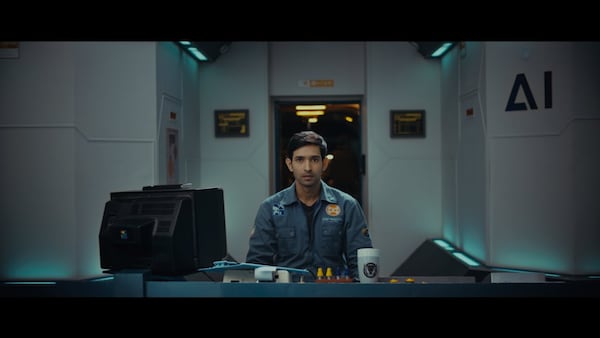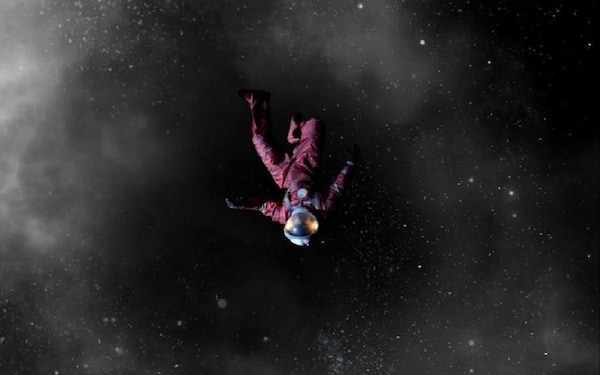Filmmaker Arati Kadav’s Grounded Visions Of Space

- Gayle Sequeira
Film Companion
Last Updated: 01.38 PM, Jul 23, 2022

In The Astronaut and his Parrot (2022), now playing at Montreal’s Fantasia Film Festival, mechanical engineer Iqbal Ali (Ali Fazal) attempts to contact mission control after a space excursion goes horribly wrong, only to get his wires crossed and end up with a parrot on the other end of his call. With his oxygen supply rapidly running out, he attempts to pass on one last message to his daughter back home. For a short film with echoes of Gravity (2013) and Interstellar (2014), writer-director Arati Kadav’s The Astronaut and his Parrot has a distinct homegrown flavour. Despite following a man untethered from his shuttle and hurtling through the vastness of space, it was shot in small-scale conditions at a studio in Whistling Woods. It’s surprising to hear, but shouldn’t be — Kadav has long been perfecting the art of low-budget sci-fi filmmaking. In her 2019 feature film Cargo, set on a spaceship, actors shared costumes and props were sourced from raddiwalas. Her 2021 short film, 55 km/sec, involves a meteor on a collision-course with Earth, but the camera zooms into the loneliness of the people in its path instead.
The idea of a man falling to his death in space came to her years ago, inspired by the works of Ray Bradbury, but despite her experience, Kadav wasn’t sure if she could pull it off.
“We have the same problem every time — we want to tell stories but we just don’t have the budgets for them,” she said. “As a filmmaker with minimal resources, you don’t even know how you will shoot a man free-falling from space. How will you get a parrot to speak? There were a lot of mental blocks. There was a possibility that we could shoot the whole thing and it would look like a joke.” It was late last year when the director finally decided to just go for it, shooting the 15-minute-long film on an iPhone 12 Pro Max.
Kadav, who had known Fazal for a while and had worked with his partner, Richa Chadha on 55 km/sec, knew that she wanted to work with him. “He has that air of maturity, he looks like a convincing father. And he has the physique of an astronaut,” she says. It took just one meeting to get him on board. “I told him, ‘Just do it.’ He said, ‘You are not even asking me, you’re just telling me?’ I said, ‘Yes, because there are way too many challenges on this film, I need the person at the centre of it to make me feel super excited to be doing it’.” Fazal was in.
Next, Kadav visited several prop shops and costume stores, but couldn’t find an astronaut uniform that looked authentic. Eventually, the crew designed it themselves, perfecting it over several iterations, and got it tailored at The Design Man in Andheri. Kadav remembers buying a fabricator at IndiaMart so she could cut a transparent sphere in half to use as Ali’s helmet, some portions of which were later 3D printed.
Her crew took just four days to shoot the short film — they could only afford to hire the studio for two-and-half. An added expense was getting the cast and crew tested for Covid daily.
The idea was to shoot as much as they could practically and use minimal VFX later on. The crew set up a “black screen” instead of the usual green screen, covering the studio’s walls and parts of the floor with black cloth and black paper to create the illusion of absolute darkness and depth. “It needed to let zero light in because anything that is reflected will show its contours and ruin the effect.” For a shot in which the Earth is reflected in Iqbal’s helmet as he floats past, the crew pulled up an image of the planet on a LED TV set up opposite him. All that was left to do in post-production was to add in the stars digitally and erase the wires from which Fazal was hanging.
To make Fazal’s free fall through space look convincing with minimal computer-generated imagery (CGI), the crew devised a few visual tricks. “If you watch advertisements, for example a shampoo ad, there’s always a scene in which the bottle spins towards the camera. So we thought, why not create a human turntable and move it in a circular way?” Kadav said. “Viewers would have been able to tell if he was stationary throughout, so we used this for his mid-shots in which the astronaut is moving or rotating.” They hired the turntable and worked with Mard Ko Dard Nahi Hota action choreographer Prateek Parmar to make the action look credible.
Second to the challenge of depicting deep space inside the confines of a studio was finding a parrot, the other major character in the short film. Kadav began asking around, but discovered that Bollywood animal handlers didn’t work with desi parrots. “The Wildlife Protection Act prohibits people from keeping Indian birds like parakeets as pets. So we could only hire African parrots,” she said. After watching multiple parrot videos, she narrowed down on a bird next scheduled to appear in an Imtiaz Ali film. The team shot the bird’s portions inside a van they had rented and decorated to look like an astrologer’s workspace.
A common trick used to get parrots to look like they’re talking onscreen is to feed them peanut butter since the movement of their mouths mimics speech. When Kadav tried it out, however, she wasn’t convinced. “We took a few shots of the bird chewing but it was just not sitting well with me because I could tell he was eating something,” she says. She then realised that the bird would react to the sound of other parrots and so began playing videos of the Amazon rainforest between takes to elicit expressions of curiosity.

Parmar had worked with the VFX team while the shoot was still ongoing to figure out how they could digitally simulate Fazal’s movements through space based on the falling and spinning motions he had performed on camera. Even so, the team spent more than four months on the post-production process, touching up nearly 70 VFX shots and trying to fix the jittery camera movements.
Then came the challenge of finding someone to dub the parrot’s lines. “We were searching for the right artist for a month and a half. A lot of the dubbing artists spoke like the Disney version of a parrot would. They weren’t speaking like regular parrots,” Kadav said. The bird’s final voice was a blend of two artists, one of whom voices Chamki on Galli Galli Sim Sim, the Indian adaptation of Sesame Street.
Although Kadav sold Cargo to Netflix, she thinks it’s unlikely she’ll be able to persuade any over-the-top (OTT) platform to pick up The Astronaut and His Parrot, given how the streaming landscape has evolved over the past few years. “Earlier, OTT platforms were readily buying and licensing indie films. I think that has changed because mainstream films are also releasing on OTT. Just six months ago, you would feel like if you made a good film, one of the platforms would pick it up. Now, that probability feels low,” she says. Having written off the short as a financial loss, she’s begun taking on more writing work so she can use the income to fund her next film. It isn’t easy.

“It’s like being in a dark tunnel and not knowing where the other side is or whether your film will even see the light of the day,” she said. “You have to be strong and mentally prepared because there is so much at stake — your hard work, your money.”
The Astronaut and his Parrot, along with Cargo and 55 km/sec, all feature the recurring theme of wanting to keep someone alive long after they’re gone, of holding on to their memory as a way of immortalising them. What brings Kadav back to this idea again and again? “Even when you feel like everything is lost, something must endure. The idea of that attracts me,” she says. It’s a fitting sentiment for a filmmaker whose themes echo her persistence.

 Premium
Premium